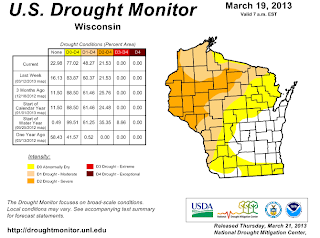If you're a weather nut like myself you'll want to mark your calendar for Saturday, April 6th as the annual Fermilab Tornado and Severe Storms Seminar will be held at Fermilab in Batavia at Noon and again at 6pm. Admission is free and the seminar is open to the public. If you plan on attending you'll want to make sure you arrive early as the seats fill up fairly quickly and are on a first come, first served basis.
Speakers for this year's seminar include:
Dr. Louis Uccellini, Director of NOAA's National Weather Service
-SuperStorm Sandy, The Largest Atlantic Hurricane and Second Costliest to Hit the U.S.
Dr. Uccellini will discuss the unusual melding of the worst features of a westward moving hurricane and an eastbound Midwest winter storm, Greenland blocking and the tidal effects of a full moon on the east coast.
Dr. Russell Schneider, Director, NWS Storm Prediction Center, Norman, OK
-The Life-Saving Mission of NOAA's Storm Prediction Center: Monitoring Severe Weather Across the U.S.
The Storm Prediction Center monitors the threat of severe weather across the U.S. - including here in northern Illinois and southern Wisconsin.
Dr. Donald J. Wuebbles, Harry E. Preble Professor of Atmospheric Sciences School of Earth, Society and Environment, Department of Atmospheric Sciences University of Illinois
-Severe Weather in the U.S. Under a Changing Climate
This presentation provides a discussion of the current understanding of climate change in the U.S. - looking at severe weather in particular.
Tom Skilling, Chief Meteorologist, WGN-TV and Radio
-Computer Models have Revolutionized Weather Forecasting, but Where Did They Come From?
Tom Skilling will discuss the development of the first digital computer at Princeton University in the 1930's and 1940's and its first tasks - Aiding the atomic bomb development and forecasting the weather.
Ed Fenelon, Meteorologist in Charge, NWS Forecast Office, Chicago/Romeoville
Impact Based Severe Weather Warnings: Getting the Severe Weather Message Out to the Public
Getting critical severe weather information out to the public when severe weather threatens is vital in saving someone's life. However, recent years have showed us that even with that information numerous lives have been lost when warnings were issued well in advance. Why has this happened and how can it be prevented? How can meteorologists at the National Weather Service and in the media clearly communicate the danger which faces a population when severe weather outbreaks occur? Ed Fenelon will discuss the effort to issue what are being referred to as 'impact based' severe weather warnings in attempt to do just that.
Jim Allsopp, Warning Coordination Meteorologist, NWS Forecast Office, Chicago/Romeoville
-50th Anniversary of the Kankakee-Medaryville Tornado of April 17th, 1963
On April 17th, 1963 one of the most powerful and long-lived tornadoes ever documented in the Chicago area touched down near the town of Essex in Kankakee County.
Brian Smith, Warning Coordination Meteorologist, NWS Omaha Nebraska
-The History of Skywarn and Storm Spotting in the U.S.
Trained spotters are vital to NWS meteorologists and are considered the backbone of the country's tornado and severe weather warning system. They provide invaluable, indispensable and ground-based observations during severe weather. Brian will discuss how the spotter network developed.


















